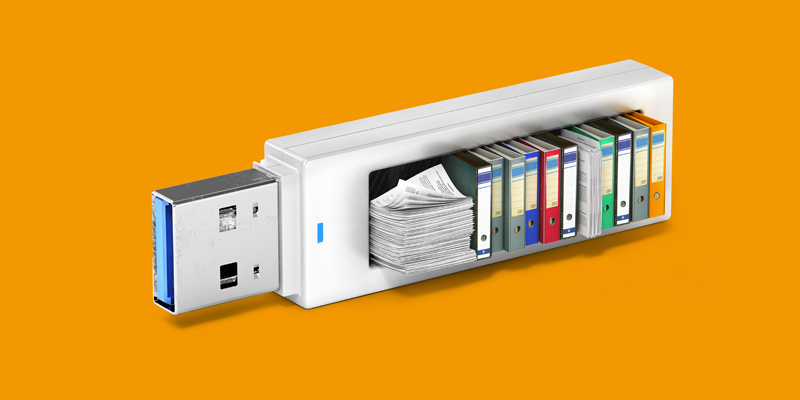
Reading time: 5 Minutes
Want to sharpen your focus at work? Try honing your ability to retain and recall important details. Matthew Jenkin shares five simple yet creative strategies for remembering more of what you read
It’s Monday morning and you’re sitting at your desk, trying to read an article that you’ll need to remember for a meeting later in the week. But wait – here’s an email from the boss you need to reply to. Suddenly the phone rings. Oh, and Sally from marketing is doing a tea round. Before you know it, your mind has been pulled in so many directions you’ve forgotten everything you just read. Sound familiar?
A recent survey by the University of California estimates that we’re bombarded with 34Gb of information a day(1), twice as much as 30 years ago. Office workers, meanwhile, are interrupted on average every three minutes. Small surprise, therefore, that our concentration spans are shrinking.
The digital age is also having a detrimental impact on our ability to retain information. Studies show(2) that the ease with which we can find information on the internet means that recall memory (the ability to spontaneously call information up in your mind) is being replaced by recognition memory (knowing where the information is and how to access it).
Whether it’s giving a presentation or learning a new skill, recall memory remains essential for success at work. So here are five ways you can help yourself to retain more of what you read.
1. Hit the pause button
A study by the University of Texas at Austin(3) found that giving yourself a few minutes to rest and think about what you have just read boosts future learning. Researcher Alison Preston(4), an associate professor of psychology and neuroscience, says this research showed that “replaying memories during rest makes those earlier memories stronger, not just impacting the original content, but impacting the memories to come.”
Swedish memory athlete Idriz Zogaj advises using this reflection time to acknowledge your emotional response to what you read. If you can allow yourself to do that, you stand a better chance of the new memories being more powerful and easier to retrieve. That’s because the brain is wired to respond to emotions quickly and efficiently(5), connecting them to memory formation(6).
He says: “Find the feeling and that is what you want to catch, because that feeling will trigger other memories of that part of the book or the whole book itself.”
Simply doing nothing and letting your mind completely rest can also help you better to retain information and focus. Daniel Levitin, author and professor of psychology, behavioural neuroscience and music at McGill University in California, explains(7): “People who take regular breaks – even naps – end up being more productive and more creative in their work. You need to give your brain time to consolidate all the information that’s come in, to toss it and turn it.”
Our ‘recall memory’ (the ability to spontaneously call information up in your mind) is being replaced by ‘recognition memory’ (knowing where the information is and how to access it)
2. Try spaced repetition
According to the ‘multi-store’ memory model(8) put forward by psychologists, if you repeat information enough times, it will go into your long-term memory, where it will (potentially) stay forever.
Spaced repetition – revisiting information regularly(9) at set intervals over time – can be a highly effective method of retaining information. It’s a technique that works because it forces learning to be effortful, and – like muscles – the brain responds to that stimulus by strengthening the connections between nerve cells. By spacing the intervals out, you’re further exercising these connections each time. It produces long-term, durable retention of knowledge(10).
A simple way to do spaced repetition is to use flashcards organised into a box(11). Set up a schedule for when you will revise the cards in each of the sections in your box. If you answer a card correctly, you put it into a section that you will revisit less frequently in the future, whereas if you get the answer wrong, you move the card into a section scheduled for frequent visits.
3. Read and write on paper
It may sound archaic in the digital age, but going old-school and reading from a hard paper copy could help you better concentrate and recall information.
A survey of 300 university students from US, Japan, Slovakia and Germany found that 92% of respondents agreed(12) that hard copy best allowed them to concentrate. Another study found that readers using an e-reader were ‘significantly’ worse than paperback readers(13) at recalling when events occurred in a mystery story.
Naomi S Baron, a linguistics professor who helped conduct the survey, believes the reason behind this is obvious – digital devices offer more temptation for distraction, and readers are therefore more likely to lose focus on what they are reading.
The pen may also be mightier than the keyboard, suggests research(14). Writing notes on paper increases conceptual understanding, application and retention.
4. Draw a mind map
Making notes can help with recall but you don’t need to write down everything. Invented by Tony Buzan(15) as a learning and memory tool while he was struggling to take effective notes as a student, a mind map is a colourful diagram with a central image representing the problem or main concept and curved branches radiating from it, each with a related keyword printed above it. Central to the success of the technique is the use of colours, pictures and a non-linear structure to encourage brainstorming.
“The mind map itself is an image you can look at and remember,” says Idriz Zogaj. “Visualising information is the strongest way to keep something in your memory. You can do it online using tools found on the iMindMap(16) website, but paper is preferable because it keeps the hand busy while the brain is thinking.”
“A blank piece of paper is always best tilted horizontally as you have better space to draw your mind map,” he adds. “You can even do it while you’re reading.”
5. Use online tools
If paper and pen seem a bit low-tech, there are plenty of apps to explore. Eidetic(17), for example, uses spaced repetition to help you memorise anything from important phone numbers to facts. You simply enter the information you want to memorise and the app uses notifications to remind you when it’s time to test yourself. It spaces the tests out over time to help you retain the information for longer.
With 70 million subscribers, Lumosity(18) is one of the best-known brain-training apps. Designed by neuroscientists, it claims to train memory and attention with a series of scientific games. Users can play three free games a day or subscribe to access more than 40 games at once.
If you’re in a hurry, speed-reading apps such as Spritz(19) claim to allow users to read at staggeringly high rates of speed: 600 or even 1,000 words per minute. Spritz can facilitate this, it says, by using the so-called RSVP (rapid serial visual presentation) method, which displays the text one word at a time in the centre of your screen. Since your eyes aren’t panning and scrolling, you can focus on a single spot on your phone and read at a faster clip as the words are swapped out like a fast-moving slideshow. Use the time you save to apply the other techniques in this article and consolidate what you’ve just read.
Matthew Jenkin is a US-based journalist and the former editor of Guardian Careers, The Guardian newspaper’s community site for job seekers and career changers
Sources:
(1) https://www.nytimes.com/2009/12/10/technology/10data.html
(2) https://www.rewireme.com/brain-insight/internet-affects-memory/
(3) https://news.utexas.edu/2014/10/20/reflection-boosts-learning
(4) https://cns.utexas.edu/component/cobalt/item/66-other/1313-preston-alison?Itemid=289
(5) http://www.hrdpress.com/site/html/includes/items/SBEI.html
(6) http://www.memory-key.com/memory/emotion
(7) https://www.kqed.org/mindshift/37711/why-daydreaming-is-critical-to-effective-learning
(8) https://www.kqed.org/mindshift/37711/why-daydreaming-is-critical-to-effective-learning
(9) http://www.ncbi.nlm.nih.gov/pmc/articles/PMC1876761/
(10) https://www.supermemo.com/english/ol/background.htm
(11) https://www.youtube.com/watch?v=33DIo8iU7ws
(12) https://www.washingtonpost.com/posteverything/wp/2015/01/12/the-case-against-kindle-why-reading-paper-books-is-better-for-your-mind-and-body/?noredirect=on&utm_term=.eb845123558c
(13) https://www.researchgate.net/profile/Jose_Pedroza_Carneiro/post/
What_positive_or_negative_experiences_can_provide_me_with_regard_to_the_introduction_of_e-readers_in_the_documentation_centers_of_universities/attachment/59d63757c49f478072ea4c08/
AS%3A273684940427264%401442262984768/download/Readers+absorb+less+on+Kindles+than+on+paper.docx
(14) http://journals.sagepub.com/doi/abs/10.1177/0956797614524581
(15) https://www.irishtimes.com/business/how-tony-buzan-used-mind-maps-to-doodle-his-way-to-millions-1.2230977
(16) https://imindmap.com/
(17) https://play.google.com/store/apps/details?id=com.yourelink.Eidetic&hl=en_GB
(18) https://www.lumosity.com/
(19) http://spritzinc.com/



